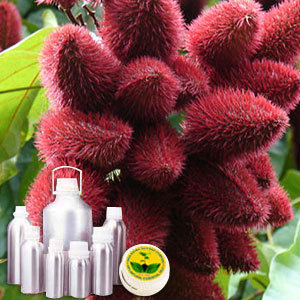Botonical Name | : | Bixa orellana L | |
CAS # | : | 1393-63-1 | |
Country of Origin | : | South America | |
Color & Odor | : | bright yellow to orange | |
Solubility | : | soluble in oil & water | |
Specific Gravity | : | 2.810 - 3.010 @ 20°C | |
Optical Rotation | : | -20°C | |
Refractive Index | : | 1.457 - 1.480 @ 20°C | |
Flash Point | : | >100°C | |
Plant Part Used | : | Seed | |
Extraction Method | : | Solvent Extraction |
DESCRIPTION:
Coming in Yellow Orange shade, it has strength of 2.0% Bixin and is a natural food colorant obtained from the seeds of the Bixa Orella tree. The pigments that produce this yellow to orange color range are carotenoids, bixin and norbixin. The concentration of color is expressed as a percentage of these compounds where content varies with extraction method. For processing, fruits are dried & then seeds extracted from them are crushed. CONSTITUENTS:
Annatto vegetable oil, propylene glycol, mono-& glycerides, potassium hydroxide, Bixin (Fat soluble part -70-80% ), norbixin (water soluble part), Propyline Glycol. AROMATIC SUMMARY / NOTE / STRENGTH OF AROMA:
Characteristic odor. BLENDS WITH:
Turmeric or paprika oleoresin. COMMON NAMES:
Urucum, colorau, achiote or bija, Bixa, atsuete, bixin, butter colour or rocou. USES:
It finds extensive usage as a constituent in Ice Creams, Margarine, Cheese, Yogurt and other dairy and food products. Other than this, it is also used in many cheeses like Cheddar, Red Leicester, Brie as well as in margarine, butter, rice, smoked fish & custard powder. It is also used as commercial food coloring and dye.


































